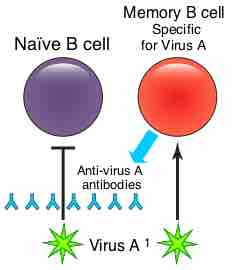Making Memory B Cells
Memory B cells are a B cell sub-type that are formed following a primary infection . In the wake of the first (primary response) infection involving a particular antigen, the responding naïve cells (ones which have never been exposed to the antigen) proliferate to produce a colony of cells. Most of them differentiate into the plasma cells, also called effector B cells (which produce the antibodies) and clear away with the resolution of infection. The rest persist as the memory cells that can survive for years, or even a lifetime.

B memory cells
B lymphocytes are the cells of the immune system that make antibodies to invading pathogens like viruses. They form memory cells that remember the same pathogen for faster antibody production in future infections. The body's immune system has a propensity to preferentially utilize immunological memory based on a previous infection when a second slightly different version of that foreign entity is encountered.
To understand the events taking place, it is important to appreciate that the antibody molecules present on a clone (a group of genetically identical cells) of B cells have a unique paratope (the sequence of amino acids that binds to the epitope on an antigen).
Each time these cells are induced to proliferate due to an infection, the genetic region coding for the paratope undergoes spontaneous mutations with a frequency of about 1 in every 1600 cell divisions. This may not seem high, but because the cells divide so often, it ends up resulting in many mutations. The frequency of mutations in other cells is around 1 in 106, which is much lower.
All these events occur in the highly "eventful" germinal centers of lymphoid follicles, within the lymph nodes.
Some of the resulting paratopes (and the cells elaborating them) have a better affinity for the antigen (actually, the epitope) and are more likely to proliferate than the others.
Moreover, the number of different clones responding to the same antigen increases (polyclonal response) with each such exposure to the antigen and a greater number of memory cells persist. Thus, a stronger (basically, larger number of antibody molecules) and more specific antibody production is the hallmark of secondary antibody response.
The fact that all the cells of a single clone elaborate one (and only one) paratope, and that the memory cells survive for long periods, is what imparts a memory to the immune response. This is the principle behind vaccination and administration of booster.
The paratope is the part of an antibody which recognizes an antigen, the antigen-binding site of an antibody. It is a small region (15–22 amino acids) of the antibody's Fv region and contains parts of the antibody's heavy and light chains. The part of the antigen to which the paratope binds is called an epitope.